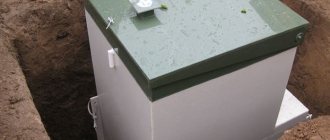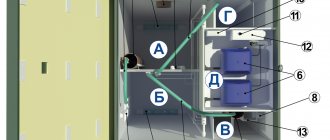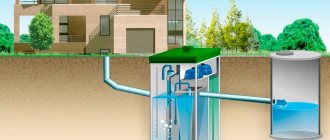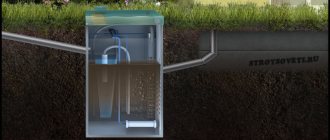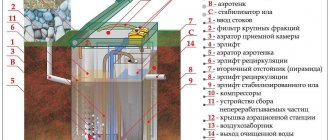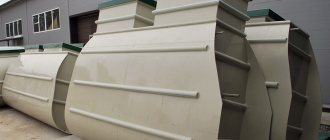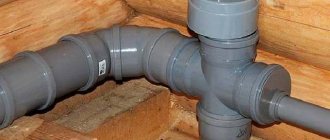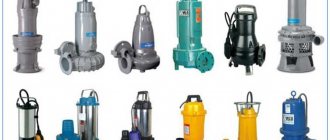Until relatively recently, biological wastewater treatment was an unshakable dream. For many, living outside the city brought a lot of trouble, because they had to build a homemade septic tank for wastewater. However, today the situation has changed significantly. Thanks to the Topas treatment system, the issue of equipping a septic tank has been effectively resolved. The cleaning process using this method is achieved thanks to microorganisms. Moreover, each stage of cleaning is carried out without possible pollution of nature.
The Topas septic tank system is environmentally friendly, and most importantly, meets all established standards for wastewater treatment. Before we look at the installation of a Topas septic tank, we will analyze its main characteristics and operating principle.
Operating principle of the Topas septic tank
As noted earlier, Topaz is a septic tank whose operating principle is to purify domestic water using special microorganisms - anaerobic bacteria. Under their influence, organic compounds decompose, are disinfected and processed into sludge.
Scheme of operation of the treatment station
First, wastewater passes into the installation chamber (sector 1 in the figure), where the first stage of purification occurs. During the process, large fractions of contaminants are eliminated, after which the water is sent to the aeration tank (sector 2) using an airlift. The latter is the main part of the septic system where active bacteria are contained. It destroys contaminants that have managed to pass the first stage.
Sludge, which is formed as a result of waste processing, acts as a binder for particles of foreign bodies contained in water. After this, all the liquid goes to the settling tank (sector 3), called the pyramid. There, the silt settles to the bottom, and the finally purified water follows further (sector 4).
Filter sludge that accumulates in the sump should be removed periodically. The recycling process is quite simple and does not require special knowledge. If you plan to use a septic tank for your Topas dacha, then the sludge can be used as fertilizer.
Design and principle of operation
Operating principle of Topas
The main cleaning processes occurring in septic tanks are the result of the vital activity of special bacteria that feed on organic matter and decompose it into elements ready for disposal.
Note!
The device does not require special cultivation of bacteria, since they reproduce independently, feeding on waste and oxygen.
A distinctive feature of the device we are considering is that its entire design is made in the form of a compact module, due to which the installation of the septic tank is noticeably simplified.
The device has four chambers and two built-in compressors that serve to support the work of bacteria, thereby accelerating the decomposition process.
The first chamber, equipped with a special float relay, serves to collect wastewater and settle it (with large particles of dirt falling to the bottom). When the chamber is filled to a certain level, the relay turns on the compressor, after which the waste is forced to move into the second chamber.
Septic tank design Topas diagram
Having passed through a coarse filter installed at the inlet of the second compartment, liquid waste enters the zone of influence of microorganisms and is cleaned of organic components. To speed up the fermentation process, oxygen is pumped into the chamber using a compressor, which helps mix the wastewater with activated sludge, which acts as a kind of filter.
Sewage saturated with bacteria and oxygen then enters the third compartment, which is used as a secondary settling tank. In the fourth chamber, the final purification of water is carried out, which leaves the septic tank through a special channel.
Characteristics of the Topas septic tank
I would like to briefly highlight the unique characteristics of this septic system. Among them are:
- cleaning efficiency (99%);
- compact design;
- low power consumption;
- absence of noise during the work process;
- Topaz-septic tank is an automated device: it does not require special operating conditions and is easy to maintain;
- tightness that prevents the spread of unpleasant odors.
Here it should be added that users can easily choose the appropriate septic tank option for their needs. Thus, different models differ from each other in the number of users.
Various models: Topas 5, Topas 8 and Topas 10.
For example, let’s compare the Topas 8 and Topas 5 septic tanks: the first is designed to serve 8 people, the second, respectively, for 5.
Benefits and Features
Here are the main unique characteristics of this installation:
- High cleaning efficiency.
- Economical power consumption.
- Compactness.
- There is no noise during operation.
- Tightness.
- Topas septic tank does not require special care during its operation.
Septic tank Topas-2
It is worth mentioning separately that such septic tanks can be individually selected to suit the needs of a particular family. For example, the Topas-8 septic tank model is capable of serving a family of eight people, and Topas-5 - five people. During its operation, a number of actions are prohibited. In principle, you can find out about this by reading the operating instructions, so now we will consider only some aspects that are strictly prohibited:
- Throw spoiled vegetables down the drain.
- Dump sand and other construction materials.
- Dispose of cigarette filters, film, rubber and other non-biodegradable compounds into the sewer.
- Dispose of water that has undergone a purification process using an oxidizing agent.
- Discard liquids containing high chlorine content.
- Discharge of drug-based drugs.
- Discharge of consumable automotive materials into the sewer.
At the same time, during the operation of the Topas septic tank it is allowed:
- Toilet paper dump.
- Discharge of water containing powder.
- Discharge of wastewater from bathhouses, kitchens and showers.
Installation of a septic tank
Installation of a septic tank can be divided into six main stages, which we will consider in more detail using the Topas 5 model as an example.
Stage 1: site preparation
The Topas septic tank instructions require installation at a distance of at least 5 meters from the foundation of the house. This recommendation is dictated by SES standards. Once the location has been determined, a pit is dug. Its dimensions are determined depending on the septic tank model. Topas 5 has dimensions of 1000x1200x1400 and for it the pit should be 1800x1800x2400. After it is dug, formwork needs to be made.
Pit preparation
Stage 2: installation of a septic tank
Next, you need to organize a sand cushion in the pit. To do this, its bottom is covered with sand to a depth of 15 cm. Thus, after installation, the septic tank will also rise above the ground surface by 15 cm. This is required for ease of operation of the cleaning system in the spring season and to prevent its damage. Otherwise, if the septic tank is installed flush with the ground, the aeration station may be flooded in the spring when the snow melts. Typically, water will get in through the vents or the top cover. In this case, the compressors, and sometimes the entire system as a whole, may stop functioning.
Descent of the station into the pit
Advice from a professional: It is necessary to choose a treatment station model taking into account the groundwater level. If it is very close to the surface, then preference should be given to varieties labeled PR. Such systems provide for forced removal of purified water, which is carried out through a built-in pump.
Septic tanks for country houses Topas (5 and 8) can be installed in the pit manually. No special equipment is required, unlike other models of these systems. A rope is threaded through special holes located on the stiffening ribs, and the station is lowered into the pit.
Stage 3: organization of the sewer system
For the installation of the sewer system, HDPE pipes with a diameter of 110 mm are used. The depth of the pipe insertion level into the septic installation is 70-80 cm relative to the upper ground level. For Long model stations, the depth varies from 120 to 140 cm. The slope of the sewer pipes depends on the diameter of the pipe:
- at 100 mm – 1-2 cm per meter;
- at 50 mm – 3 cm.
Connecting outflow and inlet lines
If the pipe was inserted at a distance of 70 cm relative to the top, then at a distance of 10 m from the house, the height of the pipe leaving the house should be 50 cm from the ground.
Stage 4: Sealing the installation
It is necessary to drill holes for the sewer pipe in the outer casing of the station. For this, it is recommended to use an adjustable crown (diameter 103-100 mm). In this case, the adjustment should be 105-108 mm. It is advisable to carry out sealing following the instructions.
The station includes a special polypropylene cord, with the help of which a pipe placed in the hole is soldered to it. To do this, use a hair dryer with an appropriate nozzle. After the pipe is securely attached, a sewer pipe is connected to it.
Wastewater treatment plant leveling
Pro tip: Before sealing, it's a good idea to level the installation using a building level.
Stage 5: Providing a Power Source
Since the system operates on electricity, the installation of a Topas septic tank involves providing power to it. For this purpose, a PVS cable is used (section 3x1.5). It is placed in a corrugated pipe intended for excavation work and placed near the sewer pipe.
The cable is brought to the installation through a special input and connected to the terminals. In the house it is connected to the distribution panel via a separate 6-16 A circuit breaker.
Stage 6: normalization of pressure
The final stage is equalizing the pressure on the outer surfaces of the station when sprinkling it. This is necessary in order to compensate for the pressure on its body. Filling the installation with water and sprinkling are carried out simultaneously and in equal quantities. The station is filled with water by a third and similarly filled by a third. The process is repeated until the station is immersed in the ground to the required level.
The station is sprinkled and filled with water evenly
Exploitation
From all of the above it is clear that installing a Topas septic tank with your own hands is quite feasible. However, if you have never encountered this kind of work before, it is better to turn to specialists. As for operation, it is not associated with great difficulties. Features of operation:
- It is recommended to clean the sump tank 1-2 times a year. If it is not possible to use sewer equipment, you can do it yourself using regular sediment. The pumped sludge is suitable for use as fertilizer.
- Replacement of compressor membranes and cleaning of filters should be carried out at intervals of 2-3 years. These procedures can also be performed independently using a screwdriver and wrench.
- The station's aeration system is replaced every 12 years. This is necessary to ensure the normal functioning of the installation. Despite the fact that all contaminants are completely recycled, it is possible that large particles may enter the septic tank. If they are not removed, this may cause the installation to malfunction.
The station is cleaned 1-2 times a year
So, maintenance of the Topas septic tank is quite simple. If the necessary measures to clean it and replace certain elements are carried out in a timely manner, the station will serve for decades.
